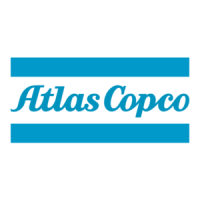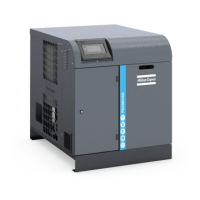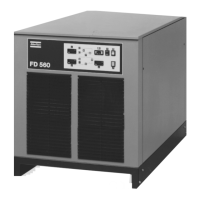2920 1351 01
16
Instruction book
energize the crankcase heater. Never start the dryer without
preheating as this may cause serious damage to the
refrigerant compressor.
Check that voltage on indicator lamp (H1) is alight.
2. On water-cooled dryers, open the cooling water shut-off
valves.
3. Press run/stand-by button (S1). Check that dryer on
indicator lamp (H2) is alight.
4. If the air inlet valve is closed, open it a little to pressurize
the dryer gradually; open the valve when the dryer is
pressurized.
5. Approx. 5 minutes later, load the dryer by opening the air
outlet valve.
Close the by-pass valve if installed.
6. After approx. 10 minutes, the nominal pressure dewpoint
temperature will be reached.
3.3 During operation
At regular intervals check:
1. Pressure dewpoint temperature gauge (P1-Fig. 10).
2. That condensate trap (1-Fig. 4a and 6-Fig. 5a) is operative.
If the operation is doubtful, flush the trap as per point 3 1).
3. Regularly open manual drain valve (2-Fig. 8) for approx.
10 seconds to discharge condensate and possible impurities.
3.4 Stopping (Fig. 10)
1. Flush the condensate trap (see section 3.3).
2. Close the dryer air outlet valve. It is not necessary to close
its air inlet valve. Only if the air net requires so, open the
by-pass valve and close the air inlet valve.
3. Press button (S1) to the stand-by position. The dryer stops.
Voltage on lamp (H1) remains alight. The crankcase heater
remains switched on. Disconnect the dryer from the mains
if it is going to be out of service for a long period or when
maintenance is needed.
Leave the isolating switch closed if the dryer has to remain
stand-by.
4. On water-cooled dryers, close the cooling water shut-off
valves.
3.5 Possible causes of unstable or too high
pressure dewpoint temperature
1. Dryer overload
- Compressed air flow exceeds capacity of dryer
- Working pressure too low
- Air inlet temperature too high
- Ambient temperature too high
- On water-cooled dryers, insufficient cooling water flow
2. Refrigeration system problems or maladjustment
- Maladjustment of the refrigerant expansion valve (7-
Fig. 4b and 9-Fig. 5b)
- Shortage of refrigerant in circuit through leakage
- Condenser externally clogged (air-cooled dryers)
- Malfunctioning of fan control switch (S3-Fig. 4b) on
air-cooled dryers or malfunctioning of the cooling water
regulating valve (3-Figs. 5) on water-cooled dryers
Note: The pressure dewpoint temperature will deviate from
nominal when the nominal conditions are exceeded, e.g. a
pressure dewpoint temperature of +7°C can be considered as
normal if the air flow, the air inlet temperature or the ambient
temperature is higher than nominal.
4 MAINTENANCE
Maintenance and repair work other than routine attention,
especially on the refrigeration circuits, must only be carried
out by qualified personnel and with the proper equipment.
Safety precautions
When handling refrigerant R404a, all applicable safety
precautions must be observed. The following points are
specially stressed:
- Contact of refrigerant with the skin will cause freezing.
Special gloves must be worn and in case of contact, the
skin should be rinsed with water. On no account may
clothing be removed.
- Fluid refrigerant will also cause freezing of the eyes;
therefore, safety glasses are a must.
- Refrigerant R404a is not inflammable but it is poisonous.
Do not inhale refrigerant vapours. Check that the working
area is adequately ventilated.
Local law may impose that:
- work on the refrigerant circuit of the cooling dryer or on
any equipment which influences its function should be
executed by an authorized control body.
- the installation should be checked once a year by an
authorized control body.
General
1. Keep the dryer clean.
2. On air-cooled dryers, brush or blow off the finned surface
of condenser (3-Figs. 4) regularly.
3. Once every six months inspect and clean the inner
components of condensate trap (1-Fig. 4a and 6-Fig. 5a).
1) - Not necessary when an electronic interval drain has been
installed.
- At initial start-up the condensate trap must be flushed more
frequently.

